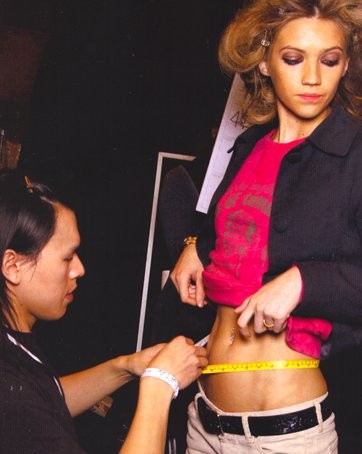|
|
|||||||||||||||||||||||||||||||
|
Fashion Designers want Guidelines for Models
But it's all voluntary, with no enforcement – and no mention of Body Mass Index. Samantha Critchell - January 15th 2007. NEW YORK – The North American fashion industry says it wants its models to be healthy, not anorexic, not bulimic and not chain-smokers. And to help models achieve that, the Council of Fashion Designers of America has released a list of recommendations as part of a new health initiative. The panel that formulated the guidelines included CFDA President Diane von Furstenberg, nutritionist Joy Bauer, modeling agent Louis Chaban, fitness trainer David Kirsch and Dr. Susan Ice, vice-president and medical director of Philadelphia's Renfrew Center, which is dedicated to eating disorders. The new guidelines come as designers are preparing to showcase their fall collections during New York Fashion Week, which starts Feb. 2. The guidelines, which are only suggestions and not binding for the industry, include the following: Keep models from 16 off the runway and don't allow models under 18 to work at fittings or photo shoots past midnight. Educate those in the industry to identify the early warning signs of eating disorders. Require models identified as having an eating disorder to receive professional help and only allow those models to continue with approval from that professional. Develop workshops on the causes and effects of eating disorders, and raise awareness of the effects of smoking and tobacco-related disease. During fashion shows, provide healthy meals and snacks, while prohibiting smoking and alcohol. What's missing from these voluntary guidelines – aside from a means of enforcement – is any mention of the Body Mass Index. In September, Madrid Fashion Week banned models with a body mass index of less than 18. The standard accepted by the World Health Organization is that anyone with an index under 18.5 is underweight. Italian government officials also got involved in this too-skinny model debate, apparently prompted in part by Spain's move and by the death in November of Brazilian model Ana Carolina Reston, who weighed 88 pounds when she died. In a December deal with the Italian fashion industry, designers agreed not to hire models younger than 16, and to require all models to submit medical proof that they do not suffer from eating disorders. "The CFDA Health Initiative is about awareness and education, not policing. Therefore, the committee is not recommending that models get a doctor's physical examination to assess their health or body-mass index to be permitted to work," says a statement from the CFDA. "Eating disorders are emotional disorders that have psychological, behavioral, social, and physical manifestations, of which body weight is only one.'' Steven Kolb, executive director for the CFDA, told the Associated Press that the designers' understanding of the issue as explained to them by health specialists is that BMI is only one factor in a long list of criteria to identify eating disorders. "A lot of the girls who work the runway are genetically thin. You go backstage and you see a lot of girls eating a lot of food and they're not gaining weight," Kolb said. Kolb, however, anticipated the question about voluntary guidelines being a strong enough statement to turn around the trend of too-thin models. "As an industry, fashion has always been concerned about health. Here at the CFDA, we've been in the forefront in terms of efforts (like) Fashion Targets Breast Cancer and HIV/AIDS awareness," he said. "As the issue of underweight models became global, we, as a group, outside of what other countries have done, decided to do something. I actually think it was a really responsible move.'' But Dr. Cynthia Bulik, a professor at the University of North Carolina at Chapel Hill and a former president of the Academy of Eating Disorders, said she'd like to see the fashion industry adopt stricter standards in an effort to protect two populations: the models and all the young girls who look up to them. "I've asked patients about what they see when they see models. They say, `I look at their skinny arms, their hip bones and their flat stomachs and then I look at myself and say I'm too fat,''' Bulik says. "It zeroes in on their self-esteem and their perceived inadequacies, and these are girls who are already underweight.'' Michael Vollbracht, the creative director at Bill Blass, which will stage its next runway show Feb. 6, agrees that the industry has an obligation to showcase apparel models who are also role models. But he also expects it will take time for industry eyes to adjust to a less-thin thin model. "Thin is always in, it's how you show clothes," Vollbracht said. But then those size 0 styles are plucked by stylists for Hollywood actresses who then feel fat – and then diet – when they can't fit into the tiny garments, and there are so many girls and women who then look up to the stars. It's a perpetual cycle, he said. Vollbracht pointed out that in the 1980s and early '90s, top models Claudia Schiffer and Cindy Crawford had more curvaceous figures. "Heroin chic changed a lot of things," he said. "It'll take some time to change back.'' The Illinois-based Academy of Eating Disorders offered its own counter-suggestions to the CFDA, using a minimum BMI of 18.5 for models over 18. That would translate into a 5-foot-9 female model weighing more than 126 pounds. An alternative formula for models between the ages of 16 and 18 would call for a 5-foot-9 teen girl to weigh more than 117 pounds. "I'm really comfortable having the WHO guidelines out there. A BMI below 18.5 is underweight. It's not the Academy of Eating Disorders is pulling this out of the air. Otherwise we're setting a standard of beauty that is officially underweight," Bulik said.
|
|
||||||||||||||||||||||||||||||
|
Website Design + SEO by designSEO.ca ~ Owned + Edited by Suzanne MacNevin | |||||||||||||||||||||||||||||||
